
Transmission is one of the powertrain components in vehicles, used to transfer the engine’s torque to the wheels. The main function of the transmission is to deliver the engine torque at the correct ratio and speed to the vehicle. Key transmission components include the gearbox, clutch, gear lever, shafts, and belts.
Transmission reman is the process of thoroughly inspecting all transmission components, replacing or refurbishing parts when necessary, and ensuring that every component functions properly. Transmission reman improves vehicle performance, enhances fuel efficiency, and extends the lifespan of the transmission system.
Transmission reman should be performed at specific mileage or time intervals. However, the vehicle’s usage patterns and operating conditions can also influence the timing of the reman.
For example, vehicles frequently carrying heavy loads or operating in stop-and-go traffic may require more frequent transmission remans.
Transmission reman should be performed by an authorized service center or an expert mechanic. This ensures that the procedures are done correctly and prevents damage to transmission components. Additionally, all necessary spare parts and the use of proper tools during the transmission reman should be handled by a skilled professional.
The transmission reman process typically begins with removing the transmission from the vehicle and completely disassembling it for a thorough inspection of all components. Damaged parts are replaced or refurbished, all components are cleaned, and then the transmission is carefully reassembled. After the reman, the transmission is tested to ensure that all parts are functioning correctly.
In conclusion, transmission reman improves vehicle performance, increases fuel efficiency, and extends the lifespan of the transmission. Therefore, it should be included in the vehicle’s maintenance schedule and performed regularly.